Composting Overview
1. Operation
- Take out a certain amount of product from the supply opening.
- Discharge it with belt conveyor.
- Put the predetermined amount of product into the bucket elevator.
- The bucket elevator throws the product into the fermenter through the opening slot.
- Add white waste soil according to the condition of the material.
- Composting process starts in the fermenter.
- Intermittent mixing with constantly blown air.
- Let moisture evaporate for 24 hours. Go back to 1.
Process
Flow
See actual composting process in COMPO.
2. Composting of livestock excrement
Unprocessed livestock excrement generally contains high moisture. It is very hard to handle and will damage roots of crops, disturbing the plant growth when applied raw.
| "" If an immature compost is applied...."" | |
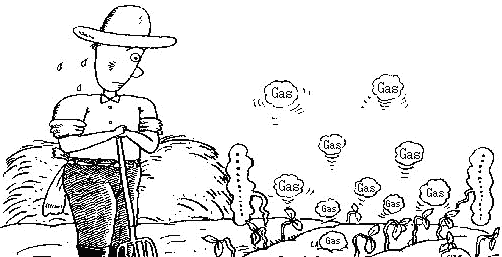 |
It produces harmful gas and plants get damaged. |
3.What is composting process
Composting process aims to turn excrement into manageable high-quality compost by letting aerobic bacteria remove the organic matter, which is produced during the decomposition process, under aerobic conditions, while evaporating moisture in the excrement.
4.To achieve best composting
Ensuring even air flow throughout excrement is important to achieve the best result because aerobic bacteria need air to continue growing and be active .
Air also plays another important role to produce manageable, low-moisture and high-quality compost. Air is needed to let the moisture evaporate from the heat released during the composting process.
This heat also kills pathogenic bacteria and weed seeds.
5.Condition and process of composting
To promote aerobic composting, creating the ideal environment for growth of aerobic bacteria is important. There are five conditions for letting aerobic composting happen.
- Aliment (organic matter)
- Easy decomposition organic matters---(Ex.) fat, sugar, carbohydrate, protein
- Hard decomposition organic matters---(Ex.) fiber, hair
- Temperature
- Moisture
- Air
- PH
To promote composting, organic materials to be decomposed as energy
source for bacteria is essential.
Organic materials include various matters.
Since hard decomposition organic matters require long time to be broken down,
rapid composting process, such as COMPO does, cannot decompose them.
Such matters are decomposed very slowly in the field, therefore they
don't produce any toxic gas such as NH3.
On the other hand, degradable organic matter decomposes rapidly if
thrown into the field and creates problems such as NH3
generation.
However, since degradable organic matter decomposes very easily in
COMPO and becomes an effective energy source, there is no gas
generation when it's applied to the field.
Bacteria needs certain temperature to be active. The ideal temperature inside COMPO is 60 to 70 Celsius. Keeping this temperature also helps to evaporate the moisture and dry the excrement.
Aerobic composting requires an adequate moisture level. If the level is too high, air circulation is disturbed and composting fails. If the level is too low, due to the lack of moisture, composting also fails. To achieve the ideal composting, 30% to 55% moisture level in COMPO is necessary.
To promote aerobic composting, providing sufficient air evenly to
excrement is essential. At a high moisture level, air flow is disturbed
and air can hardly be supplied. Therefore adequate moisture and
air-flow control are necessary.
The moisture control of COMPO is done using source manure. Also the
blades of the agitator constantly mix the manure so that the air
openings are always in motion, which let the air reach the whole
material evenly and thoroughly. This agitation is also necessary for the
evaporation of moisture.
While excrement is generally acidic (around PH6.0), PH 8.0 to 9.0 is
ideal for bacterial activity. As aerobic composting is processed, due
to the large amount of NH3 generation, it turns into alkali,
then the ideal environment for aerobes are set in place.
On the other hand, in the anaerobic environment, as a result of large
generation of lower fatty acid, the acidity level gets higher and
therefore the PH level gets lower (PH5.0 to 6.0).
In this environment, aerobes cannot grow, therefore aerobic
composting is stopped (it starts to produce sour odor)
However it can turn back to normal when the PH is adjusted and air is
supplied.
6.Composting methods
Decomposition rate of organic matter varies depending on the composting method.
- Depositing manual mixing method:1.0%/day
- Scoop method, depositing composting method:1.5%/day
- General airtight composting machine:2.5%/day
*Adding sawdust for moisture control significantly lowers the decomposition rate, because sawdust contains large amounts of persistent cellulose.
7.Typical composting methods
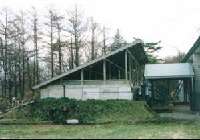
Depositing method
(compost house)

Open method
(rotary scoop mixing)
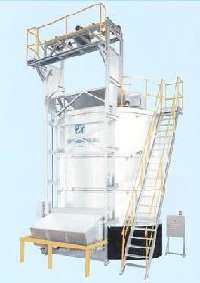
Airtight mixing method
(COMPO)
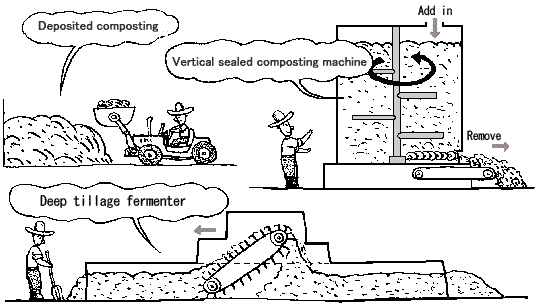
- Depositing method (compost house)
- Needs adequate moisture control
- Large space required
- A production compost will increase by using additive material.
- Mainly the ability of process is influenced by seasonal variation.
- Odor control is difficult.
- Open method (rotary scoop mixing)
- Needs adequate moisture control
- A production compost will increase by using additive material.
- Mainly the ability of process is influenced by seasonal variation.
- Odor control is difficult.
- Airtight mixing method
- High cost for equipment and electricity
- Additives (i.e. white waste activated soil) is needed.
Deposit the manure over a long period of time with manual mixing.
Equipment takes care of mixing and transfer. The result varies depending on the equipment (volume or presence of blower.)
Process composting using aerobic bacteria in an insulated fermenter.
8.Composting temperature curve
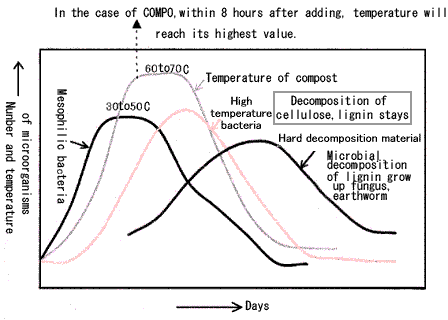
9.Composting process example
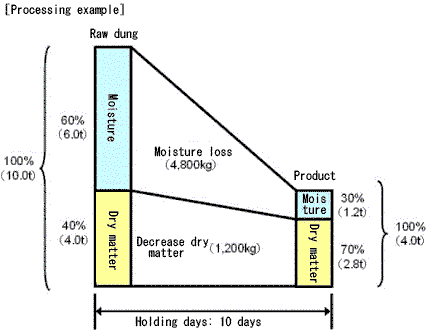
10.Calorie Calculation
During excrement fermentation, total calories produced from 1kg of decomposed dry matter is generally 4,500kcal. To evaporate 1kg of moisture requires 800kcal. The fermentation and drying capacity can be calculated from the balance of the caloric production and expenditure.
| |
3.0% per day | |
Holding time - 10 days | |
| -Decomposition rate | 3.0% | x | 10 days | = 30% |
| -Decomposing amount (reduced dried material) | 4,000kg | x | 0.3 | =1,200kg |
| -Product amount of dried material | 4,000kg | x | 0.7 | =2,800kg |
| -Product amount of material | 2,800kg | / | 0.7 | = 4,000kg |
| -Product amount of moisture in the material | 4,000kg | - | 2,800kg | =1,200kg |
| -Produced calorie from decomposition of dried matter | 1,200kg | x | 4,500kcal | =5,400,000kcal |
| 6,000kg | - | 1,200kg | =4,800kg Amount of moisture evaporated | |
| -Calories required for moisture evaporation | 4,800kg | x | 800kcal | =3,840,000kcal |
| In this case, calories produced by decomposition of dried matter is greater than calories required to evaporate moisture, therefore the process is feasible. | ||||
11.Compostiong of poultry excrement
Ammonia generation by livestock
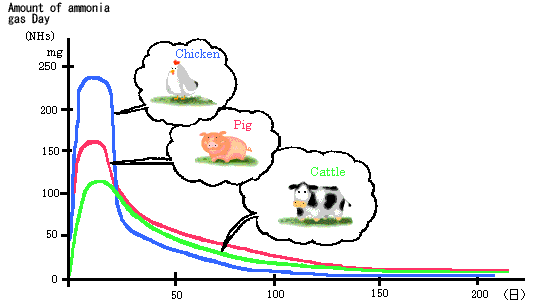
Unlike excrement from other livestock (i.e. cattle), poultry excrement appears in one form (faeces and urine together) and contains more nutritious constituents such as nitrogen, phosphoric acid and calcium. Therefore poultry-dung performs well as a fertilizer rather than soil ameliorant. However if nitrogen-rich poultry-dung is applied raw on the soil, the organic compound in the manure starts to decompose quickly, producing a large amount of ammonia gas, resulting in damage of the plants' roots.
Fermented poultry-dung on the other hand, is useful for plants because the nitrogen is already decomposed and discharged as ammonia gas, or decomposed into nitric acid or nitrous acid, during the fermentation process.
Therefore there is damage for plants resulting from ammonia gas when applied to the field.
Adding sawdust can improve the air circulation of the poultry-dung, which contains high moisture, to help fermentation. However, since lignin and cellulose in sawdust slow down the decomposition process, fermentation and decomposition will continue to process in the soil, resulting in damage for plants.
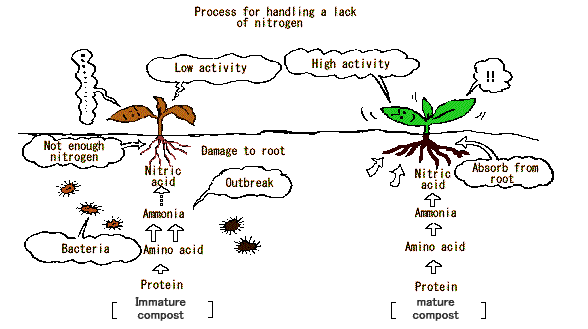
12.Deodorizing tank
During the aerobic fermentation process, the organic materials produce heat, ammonia gas,
CO2, H2O etc. Among them, the level of fetid ammonia gas is around 3,000 ppm. In this tank, the ammonia gas is biologically removed (bio-filter) and deodorized using sawdust.
Basic mechanism
When the fetid gas passes through sawdust, the odor is absorbed by sawdust or dissolved into moisture that exists between sawdust particles or in sawdust itself. With air blown for long period of time, the sawdust starts to ferment and bacteria begin to breed. The bacteria decompose the NH3 ammonia and deodorizing is processed.
Offensive odor in livestock farm mainly comes from ammonia. Ammonia easily absorbs moisture and turns into odorless nitric and nitrous acid under the aerobic environment with the activity of bacteria in the soil, especially nitrifying bacterium, to reduce the overall odor level.
Biological deodorization requires a certain environment. The temperature of the material when removed from COMPO (excrement fermentation unit) is as high as 60-80 Celsius but the temperature has to be at most 50 Celsius to introduce it into the deodorizing facility. Temperature management is one of the most important points in operating the facility.
13.Structure of COMPO
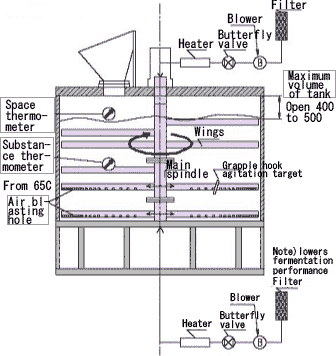
14.Concept of composting
Definition of composting
Composting is defined as "the microbial decomposition of biological waste under a controlled environment where the waste reaches to the manageable, preservable and environmental-safe state that can resolve into soil" (Goluke 1997). In other words, composting is "to decompose organic matter until a certain degree, in an aerobic environment". During the process, odor source is also decomposed and evaporated, and moisture level is reduced.
If the waste is completely decomposed, the resulting compost does not provide sufficient organic contents to the soil. Moreover it adversely affects the physical characteristic of soil such as expansion, softening, water-holding capacity and permeability as well as chemical characteristics, which also have a harmful effect on soil ecology. On the other hand, however, if the decomposition of the organic materials are not mature enough, the aerobic decomposition continues to process in the soil, resulting in oxygen deficit land. The proper condition of compost is supposed to be somewhere in between those two, but generally considered to be the state where no negative impact on crops is present. At this viewpoint, the definition above does not precisely define composting.
Composting phenomenon
The biological waste contains organic materials such as sugar, protein, carbohydrate and fat, which are metabolically decomposed or broken down into low molecular weight by bacillus, actinomycete and filamentous bacterium during the composting process. Such series of processes is referred as "Composting phenomenon". The resulting compost becomes a nourishment source for plants and realizes the circulation of materials.
15.Purpose and effect of composting
Purpose of composting
To Utilize the finished compost as organic fertilizer. Auxiliary effects for the soil are also expected.
Effects of compost
- Cycling active constituents in the soil
- Stabilize the unstable organic materials
- Eliminate the filthy impression
- Kills or deactivates bacteria, harmful insects, weed seeds etc.
- Reduce the volume of food waste
- Decompose biodegradable plastics
- Preserves a function as biological pesticide
Active constituents such as N, P, K, which originally exist in the soil, are absorbed by plants to grow. Composting is a part of the cycling system that move those constituents back to the soil.
Biological waste is unstable because it contains large amount of
organic materials to be decomposed by bacteria. If it is applied raw,
aerobic decomposition is quickly processed in the soil, resulting in
oxygen deficit land. This prevents roots of crops from breathing.
Composting lets the aerobic decomposition happen during the process to
stabilize the organic materials so that the cycling system is
accomplished when applied to the soil.
Composting turns livestock excrement into something that looks like soil. The filthy odor is eliminated and the heat from aerobic decomposition dries them out. The dried compost is easy to manage, which improves operating efficiency, and does not have the original dirty image anymore.
When the composting is processed well, it naturally heats up. The
temperature is high enough to meet the requirement of EPA (US
Environmental Protection Agency) standard (EPA requires that the
material should be exposed more than three days at 55 Celsius or
higher) to kill harmful bacteria and vermin (including eggs).
Also deactivation of weed seeds in the livestock excrement prevents the
disruption of a botanical ecosystem that could be caused by foreign
seed.
Food waste with a high water content, such as kitchen garbage, tends to lower the incinerator performance and have a possibility of dioxin contamination when burned. Instead of taking those risks, composting food waste, that is, decomposing organic materials, is a possible way to reduce the garbage volume.
Biodegradable plastics were thought to be persistent in the soil and hard to make a practical application. However recent research confirmed that composting the biodegradable plastics could accelerate the decomposition (Kimura and Nakasaki et al., 1999), which enhances the possibility that society starts to use biodegradable plastics instead of petroleum-derived general-purpose plastics, which can change the resource recycling system.
Some compost keeps a bacteria group which controls plant disease and
acts as a biological pesticide.
(Nakasaki et al.:
A New Operation for Production
Disease-Suppressive Compost from Grass Clippings,
Appl.Emviron.Microbiol,64(10),4015-4020,1998)
As described above, compost has many benefits. Besides that, it is easy to produce and approachable.
Composting does not require any special bacteria, therefore the cost is very low. All you need is to allow the material (waste) to contact the oxygen (air) . This simple and easy way is the reason composting is very approachable.
16.Things you should keep in mind about composting
- Offensive odor
- Moisture adjusting material
Generation of sulphur compound (at the first stage of reaction) and
ammonia (while organic decomposition is intense after the temperature
rises) causes offensive odor.
Bio-filter method using nitrifying bacterium is the cheap and effective
countermeasure.
Livestock excrement and food waste originally contain more than 85%
water, therefore moisture control is essential for composting.
At high moisture level, water gets into and between the materials,
which blocks oxygen supply to the bacteria that reside in the
materials. As a result, the bacteria, which are supposed to process the
compost, stop growing.
Expandable, softening and dry materials such as wooden chips, saw dust
and chaffs are currently often used to ensure the air passage.
However if too many bulking agents are added to the waste, this can
lead to an increase in compost amount as well as the operation cost.
17.Present situation and issues of compost application
- Present situation in compost application
- The application amount from the view of environmental preservative
- To ensure good quality and harvest of the crops and prevent any negative effects
- When the chemical fertilizer does not give any instruction about compost application.
- After the amount of compost is determined
- Application technology for environmental preservation
There are not so many agricultural farmers who actively utilize
compost. However for the farmers who are using compost, they tend to be
enthusiastic and most of them produce their own compost.
Vegetable farmers use compost the most. The objects of application are
rice, fruit tree, oats and tea etc.
Application amount is 1-2 ton/10a for rice, 5 ton/10a or higher for
facility-grown vegetables, 3-5 ton/10a for fruit tree and the amount
greatly varies for garden-grown vegetables depending of the species.
Establishing a reasonable guideline for application technique is
important from the point of view of environmental preservation.
The application of adequate amount of livestock compost does not only
nourishes crops but also improves the characteristic of the soil
physically, chemically and biologically. However overuse the compost
causes various adverse affect. There is a proper amount that can ensure
the high quality harvest and yet does not cause any environmental
pollution.
There is some compost whose mineralization speed is very slow. Such
compost does not nourish soil at earlier stage, therefore crop may show
poor initial development from lack of nourishment.
Applying the nourishing compost on the soil where chemical fertilizer
is already used, excessive nutrients can impair the quality of crops
and decrease the harvest. Drainage can also cause environmental
pollution.
Livestock compost requires a long time to decompose. The compost builds
up in the soil and discharges its nutrients over the long period of
time. Compost is great to get solid power. However if it is used year
after year, the amount of mineralized nutrients is increased and
accumulated (cumulative effect.)
Therefore, the basic principle of the application is, to balance the
nutrients in the soil, taking the cumulative effect in consideration,
by adding chemical fertilizer or reducing the amount of compost.
The Livestock Environmental Measure Committee
provides following basic guidelines for the application amount of
livestock compost.
For the requirement of three principle nutrients, conform to the application standard by crop, that was published rather recently. Even when a large amount of livestock compost is applied, the total amount of three nutrients, together with the active constituent in the compost and chemical fertilizer, has to meet the standard.
Amount of compost can be calculated as follows. Based on general
substitution rate (cattle: 30%, pig or chicken: 60%), reduce the amount
of nitrogen in the chemical fertilizer's application standard. From the
relative efficiencies of nitrogen in the compost (cattle compost: 30%,
pig compost: 50%, dried chicken manure: 70%), calculate the amount of
compost which contains enough nitrogen to substitute the reduced
nitrogen from the chemical fertilizer.
The relative efficiencies above are general figures and can vary
depending on compost processing, bulking agent and degree of maturity.
If other numbers are specified, use that figure.
Compost application amount (t/ha) =
Nitrogen requirement(kg/ha)×Substitution rate(%)/100×100/
compost
nitrogen content(%)×100/relative efficiency(%)×10-³
The balance of three principle nutrients in livestock excrement is
usually different from the application standard. Therefore, when
calculation is done based only on one of the nutrients, other nutrients
are likely to be excessive.
If that is the case, when any of the three nutrients is excessive,
reduce the amount of the compost so that the excessive nutrient meets
the application standard. For the other nutrients, compensate them with
chemical fertilizer to keep the amount of nutrients balanced as stated
in the standard.
Calculate the total amount of nitrogen contained in both chemical fertilizer and compost. Assuming that the total amount of nitrogen is applied, if nitrite nitrogen in seepage water does not exceed the standard value(100mg/L), that amount of nitrogen is the maximum for the crop quantity and quality. If the nitrite nitrogen appears to exceed the standard, calculate the total nitrogen amount that makes the level 100ml/L based on previous test results, then use the figure as the maximum value.
If this calculation method is applied, for feed crop, the maximum amount of total nitrogen from compost will be around 200kg/ha, and maximum amount of total nitrogen including chemical fertilizer will up to 350kg/ha.
The fertilizer or organic fertilizer application technology for
environmental preservation refers to the application technique to
increase the nutrient utilization rate (absorptivity) of the field
crop, and to prevent the substances from discharging to the environment
at the same time. If fertilizer or organic materials are applied in a
full-layer, not all nutrients can reach the roots of the crop.
Therefore topical (local) application is used to maximize the
efficiency.
The percentage of uncollected nitrogen for total applied nitrogen is
called nitrogen balance. Application technology for environmental
preservation is the technique to make the nitrogen balance as minimum
as possible.
Topically applying the adjustable fertilizer and compost, with reduced
amount of input nitrogen, will increase the utilization rate of
nitrogen. As a result, the nitrogen collected by the crop remains the
same while the nitrogen balance is significantly lowered.